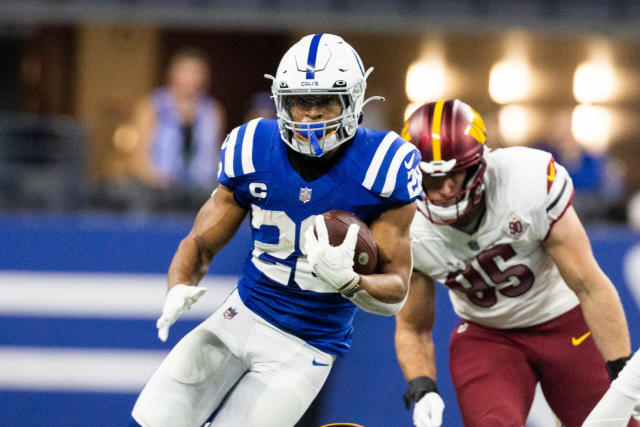
As the Indianapolis Colts prepare for their Week 5 matchup against the Jacksonville Jaguars, the absence of star running back Jonathan Taylor has become a focal point for fans and analysts alike. The reasons behind Taylor’s sidelining are multifaceted, involving a mix of injury recovery, contract disputes, and strategic team considerations. This article explores the complexities surrounding Taylor’s situation and its implications for the Colts.
Injury Concerns

At the heart of Jonathan Taylor’s absence is an ankle injury that has been a lingering issue since last season. Taylor underwent surgery in January to address a problematic ankle, which affected his performance in 2022, limiting him to just 11 games. Despite the surgery, the Colts have adopted a cautious approach in bringing him back, prioritizing his long-term health over immediate contributions.
Reports indicate that while Taylor has been progressing in his recovery, he hasn’t yet returned to full practice. The Colts’ medical staff has been deliberate in their assessment, emphasizing the need for Taylor to be fully healthy before rejoining the lineup. The decision not to rush him back is rooted in a commitment to his future and the broader strategy of maintaining a competitive roster throughout the season.
Contract Dispute
In addition to his injury, Taylor’s situation is complicated by ongoing contract negotiations. Heading into the 2023 season, Taylor was looking for a new deal that would reflect his status as one of the league’s top running backs. However, the Colts have been hesitant to meet his demands, which has created tension between the player and the organization.
This contract dispute is particularly significant in the current climate of the NFL, where running backs are finding it increasingly difficult to secure lucrative, long-term contracts. Taylor, who led the league in rushing yards and touchdowns in 2021, is aware of his value but faces a franchise unwilling to invest heavily in a position that is often undervalued in modern football. As a result, his absence from the field can also be viewed as a strategic choice—one that underscores the complexities of player management in the NFL.
The Impact on the Colts
The impact of Taylor’s absence on the Colts cannot be overstated. In 2021, he was not only the focal point of the offense but also a player who could change the momentum of a game with his explosive playmaking ability. With Taylor out, the Colts have had to rely on backup running backs like Zach Moss and rookie Evan Hull, both of whom have shown flashes of potential but lack Taylor’s game-changing capabilities.
Moss, in particular, has stepped up in Taylor’s absence, showcasing his ability to handle a larger workload. He has provided a solid rushing option, but he is not the same dynamic threat that Taylor represents. This has led to a more conservative offensive approach, as defenses can key in on the passing game without the looming threat of an elite running back.
Coaching and Strategy
Head Coach Shane Steichen’s approach to the situation has been methodical. He has repeatedly emphasized the importance of player health, which aligns with the organization’s long-term goals. Steichen understands that rushing Taylor back onto the field could jeopardize not only his health but also the team’s overall performance later in the season.
The coaching staff has had to adapt its game plan in light of Taylor’s absence. The Colts have shifted towards a more pass-heavy offense, focusing on developing their young quarterback, Anthony Richardson. This change in strategy comes with its own set of challenges, as the team navigates the growing pains of a rookie quarterback while trying to find offensive balance without a star running back.
Team Dynamics
The absence of a player like Taylor also has significant implications for team dynamics. Taylor is not just a talent on the field; he is a leader in the locker room. His presence inspires younger players and helps foster a competitive spirit within the team. Without him, there can be a psychological impact, as the team must rally together to fill the void left by one of their star players.
However, this situation can also present an opportunity for growth. Other players are forced to step up, and the team can develop depth and resilience. The Colts’ ability to adapt and thrive in this environment will be a testament to their overall character and coaching.
Looking Ahead
As the Colts face the Jaguars, the question looms: when will Jonathan Taylor return? The team has been noncommittal about a specific timeline, but optimism exists. With the Colts needing to remain competitive in the AFC South, the urgency for Taylor’s return grows, especially given the team’s aspirations for a playoff run.
However, the organization must balance the desire to win now with the need to ensure Taylor is fully recovered and in sync with the offense when he does return. The Colts have a challenging schedule ahead, and having their star running back back in action could significantly alter their offensive capabilities.

Conclusion
In summary, Jonathan Taylor’s absence from the Colts’ Week 5 matchup against the Jaguars is the result of a complex interplay of injury recovery and contract negotiations. The Colts’ cautious approach is aimed at ensuring his long-term health while navigating the financial implications of a contract dispute. Taylor’s absence has forced the team to adapt its offensive strategy, impacting their overall performance and dynamics.
As the Colts continue to face challenges without their star running back, the hope remains that Taylor will return soon—fully healthy and ready to contribute. His return could be a pivotal moment for the Colts as they aim for success in a competitive NFL landscape. Fans and analysts will undoubtedly keep a close eye on this evolving situation, as the impact of Taylor’s presence—or absence—will resonate througout the season

Leave a Reply